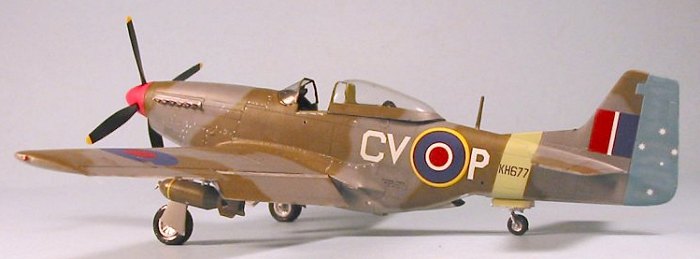
|
KIT: |
ICM 1/48 P-51D Mustang IV |
|
KIT # |
? |
|
PRICE: |
$15.95 |
|
DECALS: |
Not worth mentioning |
|
REVIEWER: |
Tom Cleaver |
|
NOTES: |

|
HISTORY |
The Royal Air Force may have been the service that believed in North American’s Mustang fighter enough to pay for its initial development and entry into service, but once the Mustang airframe was mated to the Merlin engine and the USAAF became aware of the fact that this had turned the Mustang into the best long range escort fighter of the war, the RAF became the “poor relation” when it came to obtaining more Mustangs.
In the event, most RAF Mustangs came from the
North American plant in Dallas, which had been established to back up
production from the plant in Los Angeles. The majority of all Mustang
IIIs - other than the first 300 delivered in late 1943-early 1944 - were
P-51Cs from the Dallas plant. All of the Mustang IVs the RAF received
were P-51Ks from the Dallas plant. The only difference between the P-51K
and the better-known P-51D was the substitution of an Aeroproducts
propeller for  the
Hamilton-Standard of the D. This prop resulted in a loss of about 25
m.p.h. in top speed as compared with the D, which meant that the K model
could not be operated alongside the D model by USAAF squadrons; the only
USAAF group to operate the P-51K in any numbers was the 357th
Fighter Group of the 8th Air Force. One could legitimately
term the P-51K a “cast off” model, which is why almost all of its
production could be dedicated to providing new Mustangs for the RAF.
the
Hamilton-Standard of the D. This prop resulted in a loss of about 25
m.p.h. in top speed as compared with the D, which meant that the K model
could not be operated alongside the D model by USAAF squadrons; the only
USAAF group to operate the P-51K in any numbers was the 357th
Fighter Group of the 8th Air Force. One could legitimately
term the P-51K a “cast off” model, which is why almost all of its
production could be dedicated to providing new Mustangs for the RAF.
While RAF units in the ETO had begun receiving Merlin Mustangs as early as December 1943 when 19 Squadron first took theirs on charge, the Mustang did not reach any RAF or Commonwealth air force units in the Mediterranean Theater until the late summer of 1944 - after the fighter groups of the 15th Air Force had re-equipped with P-51Cs and P-51Ds in time for the battles against Romanian oil that summer.
3 Squadron, RAAF, had been the first Australian Air Force squadron to deploy to the Middle East, arriving in Egypt in 1940 in time to become one of the leading units of what became known as the Desert Air Force. Originally equipped with Gladiators, the squadron had been among the first to operate Hurricanes, before moving on to fly Lend-Lease Curtiss Tomahawks and Kittyhawks from mid-1941, becoming one of only two RAF units to operate the Merlin-powered P-40F and P-40L Warhawks. The squadron had run up a respectable score against the Regia Aeronautica and Luftwaffe in North Africa. By the time the squadron flew in the invasion of Sicily, they were primarily involved in providing ground support as fighter bombers with the P-40F/Kittyhawk II. They moved on into Italy with the invasion in the fall of 1943, flying the P-40L/Kittyhawk IIa in the fighter-bomber role. These were replaced in 1944 by the P-40N/Kittyhawk IV, as the Italian campaign increasingly became a backwater.
In November, 1944, the squadron received Mustangs. These were primarily P-51C/Mustang III aircraft, but they also included a few P-51K/Mustang IVs, which were assigned to Squadron Leader Murray Nash and the flight leaders. There was little possibility of using the Mustang in the air-to-air role, inasmuch as there was virtually no enemy air force left in northern Italy. With their increased range, the squadron was able to operate in support of partisan forces in Yugoslavia in the dive-bombing role, carrying two 500-lb bombs as their offensive load. During the first month of operations after converting on to the Mustang, the squadron experienced no difficulties with the new airplanes, though they were frequently frustrated in carrying out their missions by the worst winter weather to hit Europe in fifty years. The increased range of the new fighters allowed the unit to fly a particularly successful train-busting sweep on Christmas Day, with 11 Mustangs using all their bombs and ammo on several trains encountered during the sweep.
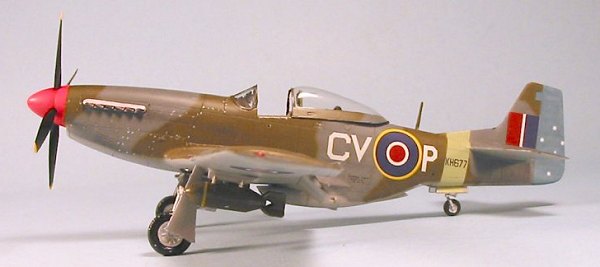 On Boxing
Day, December 26, 1944, 3 Squadron was involved in their last air-to-air
combat of the war.
On Boxing
Day, December 26, 1944, 3 Squadron was involved in their last air-to-air
combat of the war.
The squadron used 8 Mustangs for a morning mission against a bridge in Yugoslavia that had to be aborted due to weather over the target being completely closed in.
That afternoon, Squadron Leader Nash led another 8 Mustangs on a mission to cut a railway line in the town of Pordenone. With the winter sun setting, the two 4-plane flights were over the Piave River at 9,000 feet, flying straight and level.
Above, Captain Ugo Drago, C.O. of the 1st Squadriglia of the 2nd Gruppo Caccia of the Aviazonne Nazionale Repubblicana, led ten Bf-109s which had taken off from Aviano airfield to intercept the Australians. Drago was a leading pilot of the ANR, with 12 victories over four years of combat. A measure of how good he was can be seen in the fact that in operations between February 1944 and March 1945, his squadron suffered only two combat losses.
Pilot Officer Ken Caldecott called a warning when he saw a Bf-109 open fire on Pilot Officer Jack Quinn’s Mustang III, scoring hits on the engine and sending Quinn into a spinning dive. The others jettisoned their bombs as Drago gave Caldecott a burst and pulled away, leaving the Aussies looking for their attackers. Nash took the formation down to low altitude and headed for Aviano, to hit the enemy when they came in to land.
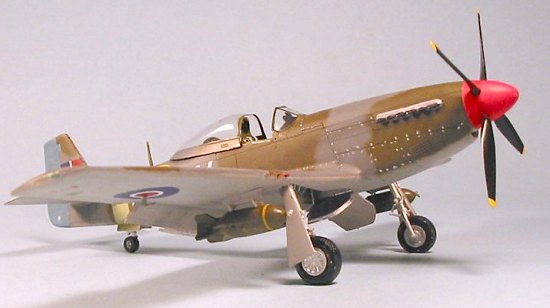 Just south of
Aviano, Nash then spotted another B-109 4,000 feet above the Aussie
formation. Nash and the others came up in the 109s blind spot and Flight
Lieutenant Max Thomas opened fire, missing. The Italian pilot then dived
for the protection of the anti-aircraft fire at Aviano, chased by Nash
and his wingman, Bill Andrews. Nash quickly closed to within 100 yards
of the 109, flying through what he later termed “medium flak,” to file a
““kill”” claim!
Drago then decided that they had achieved enough success and he
instructed his men to disengage.
Just south of
Aviano, Nash then spotted another B-109 4,000 feet above the Aussie
formation. Nash and the others came up in the 109s blind spot and Flight
Lieutenant Max Thomas opened fire, missing. The Italian pilot then dived
for the protection of the anti-aircraft fire at Aviano, chased by Nash
and his wingman, Bill Andrews. Nash quickly closed to within 100 yards
of the 109, flying through what he later termed “medium flak,” to file a
““kill”” claim!
Drago then decided that they had achieved enough success and he
instructed his men to disengage.
Everything had happened so quickly that it took some moments for the Australians to piece together that they had been attacked by enemy aircraft and to identify the fallen Mustang as Quinn’s. (Several Allied aircraft had been seen earlier in the flight and mistaken ““friendly fire”” attacks were a common risk ……) Nash then decided to patrol his formation at low altitude to the south of the Aviano airbase to see if they could snare the returning Italian fighters. Scoring hits with three long bursts, the enemy fighter belched coolant. Nash pulled off, thinking the 109 would go in, but when it stayed airborne Andrews went after it, getting hits on the port wing and cockpit. The 109s wheels dropped down, the hydraulics shot away. Andrews pulled off and Max Thomas bored in, adding more hits. The Italian pilot then dove at full speed into a vineyard in a spectacular crash. As the 109 came to a halt, the pilot sprang out of the cockpit and ran for his life. The Aussies had lost sight of the Messerschmitt just before the crash, and only put in a claim for a “damaged.”
3 Squadron continued to fly dive-bombing missions until the end of the war came in Italy in April, losing several Mustangs but only more pilots killed.
|
THE KIT |
ICM, a Ukraine-based plastics manufacturer, announced release of several P-51 kits in 2002. When these appeared in 2003, they were quickly seen as knock-offs of the Accurate Miniatures Allison Mustangs, and the Tamiya P-51B and P-51D, with sufficient changes in details to avoid a lawsuit for copyright violation.
The A-M knock-offs - released as an RAF Mustang II - seem to have all been produced without the main gear doors, and with the nose parts for the P-51 rather than for the P-51A supplied. They also have the same wing as the P-51B kit, which means they are basically a waste of time and money.
 The Tamiya
knock-offs are another story. Externally, these are kits that will make
up the same way as the Tamiya original. (Follow
this link for a look
at the P-51B). The cockpit detail provided in the kits is a combination
of semi-accurate moldings on the inside of the fuselage half, and a sprue
of parts taken from the Accurate Miniatures kit - which are completely
inaccurate for either the P-51B or P-51D. What is there can be turned
into an acceptable Mustang cockpit with a bit of scratchbuilding, but the
better solution is a True Details resin cockpit. The clear canopies are
not very clear, but they are also irrelevant, since it is easy to replace
them with the Squadron (Falcon) Vacuform canopies, which are clear,
accurate, and fit like a dream.
The Tamiya
knock-offs are another story. Externally, these are kits that will make
up the same way as the Tamiya original. (Follow
this link for a look
at the P-51B). The cockpit detail provided in the kits is a combination
of semi-accurate moldings on the inside of the fuselage half, and a sprue
of parts taken from the Accurate Miniatures kit - which are completely
inaccurate for either the P-51B or P-51D. What is there can be turned
into an acceptable Mustang cockpit with a bit of scratchbuilding, but the
better solution is a True Details resin cockpit. The clear canopies are
not very clear, but they are also irrelevant, since it is easy to replace
them with the Squadron (Falcon) Vacuform canopies, which are clear,
accurate, and fit like a dream.
The decals are mostly forgettable, though if one were to Future the decal sheet, an acceptable set of servicing stencils would then exist. Again, this is not a problem, given the numbers of accurate aftermarket decal sheets that are available for both kits.
The big value of these two kits - which will now be released by Alanger since the bankruptcy of ICM - is that they are close to half as expensive as the Tamiya kits, which makes them a bargain even with the purchase of a resin cockpit, vacuform canopy and aftermarket decal sheet.
Given that I have a set of Mustang canopies from the new Falcon “Mustang Special” set, a box full of aftermarket decals, and several True Details cockpit sets for P-51s, I decided that I would make the most of the several copies of the kit that were recently laid on me by a friend who didn’t want them.
|
CONSTRUCTION |
Since the Falcon canopy set included a flat-top “Dallas” canopy, and I had the Red Roo Decals sheet for Squadron Leader Nash’s airplane, as well as a set of Aeroproducts prop blades from a Hasegawa Mustang kit, I decided to proceed with construction of a Mustang IV in these markings.
The first thing I did was paint the True Details cockpit in Interior Green, and then pick out the details. I sanded the interior of the fuselage halves smooth, then attached the cockpit walls.
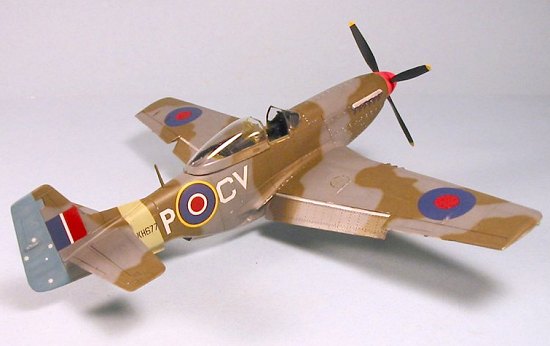 One thing to
be very aware of when you are building a Tamiya Mustang with a resin
cockpit is to be absolutely certain to sand down the resin side walls as
thin as possible - till you can see light through the resin, and to sand
down the fuselage halves in the area of the cockpit until they are about
half as thick as they started. Match the resin floor to the plastic part
and sand it down until it is only as wide as the original part. If you do
not do this, the result will be that the cockpit will be just too wide
for the fuselage, which will bow out ever so slightly. You won’t notice
this problem exists until you go to attach the wing sub-assembly to the
fuselage sub-assembly, at which point the wings will only attach by
widening out a sufficient distance to get rid of the dihedral. A “no
dihedral” Mustang looks just plain stupid - though I have seen more than
a few of them proudly displayed by their builders; follow my solution to
this problem and you will have no difficulties.
One thing to
be very aware of when you are building a Tamiya Mustang with a resin
cockpit is to be absolutely certain to sand down the resin side walls as
thin as possible - till you can see light through the resin, and to sand
down the fuselage halves in the area of the cockpit until they are about
half as thick as they started. Match the resin floor to the plastic part
and sand it down until it is only as wide as the original part. If you do
not do this, the result will be that the cockpit will be just too wide
for the fuselage, which will bow out ever so slightly. You won’t notice
this problem exists until you go to attach the wing sub-assembly to the
fuselage sub-assembly, at which point the wings will only attach by
widening out a sufficient distance to get rid of the dihedral. A “no
dihedral” Mustang looks just plain stupid - though I have seen more than
a few of them proudly displayed by their builders; follow my solution to
this problem and you will have no difficulties.
One other thing that is different from the Tamiya original is that there are no tabs for attaching the flap to the wing. This isn’t really a problem - just glue the flap in the down position and set things aside for the glue to set up solidly before handling that sub-assembly in further work.
When the model was assembled, I cut the “Dallas” canopy out of the Falcon set, and dipped it in Future. When that was dry, I masked off the clear areas with Scotch Brand Invisible Tape (which leaves no residue when you pull it up). The model was ready for painting.
|
COLORS AND MARKINGS |
Painting:
The first Mustang
IVs produced in Dallas were painted in camouflage. This was the US
“equivalent colors” of Sea Grey for Ocean Grey, Olive Drab for Dark
Green, and Sky Grey for Sea Grey Medium. These were painted without
masks or matts, and had a soft edge. I used Tamiya “Dark Grey”, and “Sky
Grey,” and Gunze-Sangyo “Olive Drab”. The Red Roo Decals have a good
4-view painting guide, which I followed in freehanding the camouflage.
When the airplanes got to the RAF, they were painted with a red spinner
as a theater identifier, and given a sky fuselage band with RAF colors.
I use Tamiya “Sky” which is
 a perfect match for
the RAF World War II “Sky” color. The spinner was painted “Post Office
Red,” (a bright scarlet for non-Brits), and I used Gunze-Sangyo “Shine
Red” for that.
a perfect match for
the RAF World War II “Sky” color. The spinner was painted “Post Office
Red,” (a bright scarlet for non-Brits), and I used Gunze-Sangyo “Shine
Red” for that.
I’ve recently received some questions by e-mail about painting camouflage. Let me give an answer here to everyone. When air brushing, go from lighter to darker. This is because of the fact that dark overspray on a lighter color will not be as obvious as light overspray on a darker color. Thus, I start with the underside color, then the upper side grey color, and finally the upper side green color. This is all done over a pre-shading of flat black airbrushed over the panel lines, with the camouflage colors thinned to the point that when they are completely applied the darker color beneath will show through - but only slightly!
I painted the canopy with black for the interior color (done on the outside), and then painted with the camouflage colors to match the pattern around the cockpit.
When this was done, I gave the model a coat of Future.
Decals:
The Red Roo Decals went down under Micro-Sol without a problem. I used the kit servicing stencil decals. When all was done, I washed the model to get rid of dried decal solvent, and then gave the model another coat of Future.
|
FINAL CONSTRUCTION |
The model was given three coats of thinned Dullcote. When that was dry, I unmasked the canopy and cut it loose from its backing. When you are cutting a vacuform canopy, use a brand new sharp #11 blade - run it around the base of the canopy, scoring it through the plastic. Keep repeating it until you cut the canopy free. Sand down the edge lightly to smooth it, then repaint as necessary for any place where paint might have chipped off.
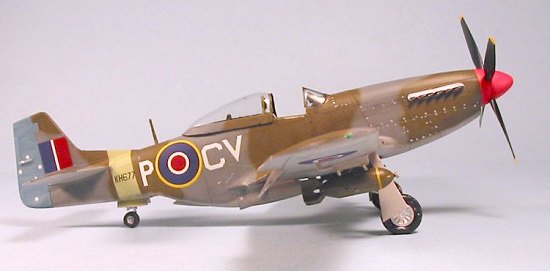 It is easy to
attach the landing gear in the right position, if the modeler takes a
moment to notice that the mounting plate for the gear inside the wheel
well is at an angle. If you make certain that the gear leg is
perpendicular to this plate - and not to the wing! - you’ll get the gear
installed correctly.
It is easy to
attach the landing gear in the right position, if the modeler takes a
moment to notice that the mounting plate for the gear inside the wheel
well is at an angle. If you make certain that the gear leg is
perpendicular to this plate - and not to the wing! - you’ll get the gear
installed correctly.
I used 500-lb bombs from an Accurate Miniatures TBF kit, and sway braces from a Hasegawa Mustang kit. I had to trim the base of the Hasegawa Aeroproducts propeller blades so they would fit in the spinner.
Since the airplane was new as of the combat action on December 26, 1944, I only “dinged” it with some exhaust staining, and chipping the cowling and wing fairing fasteners.
One nice thing is the ICM kit includes the internal brace for the canopy, with the holes in it as it should be. I attached this inside the canopy and glued it and the windscreen in place with Micro Krystal Kleer. Please note how the canopy does not stick up on space, but rather slides along the top of the fuselage over the slot. This is the proper position for a Mustang canopy in the open position.
|
CONCLUSIONS |
Another Mustang. In my book, there’s no such thing as too many Mustangs in one’s collection. With the addition of this Mustang IV, I now have my RAF Mustang collection almost complete.
February 2004
Kit courtesy of my wallet.
If you would like your product reviewed fairly and quickly by a site that has nearly 250,000 visitors a month, please contact me or see other details in the Note to Contributors.